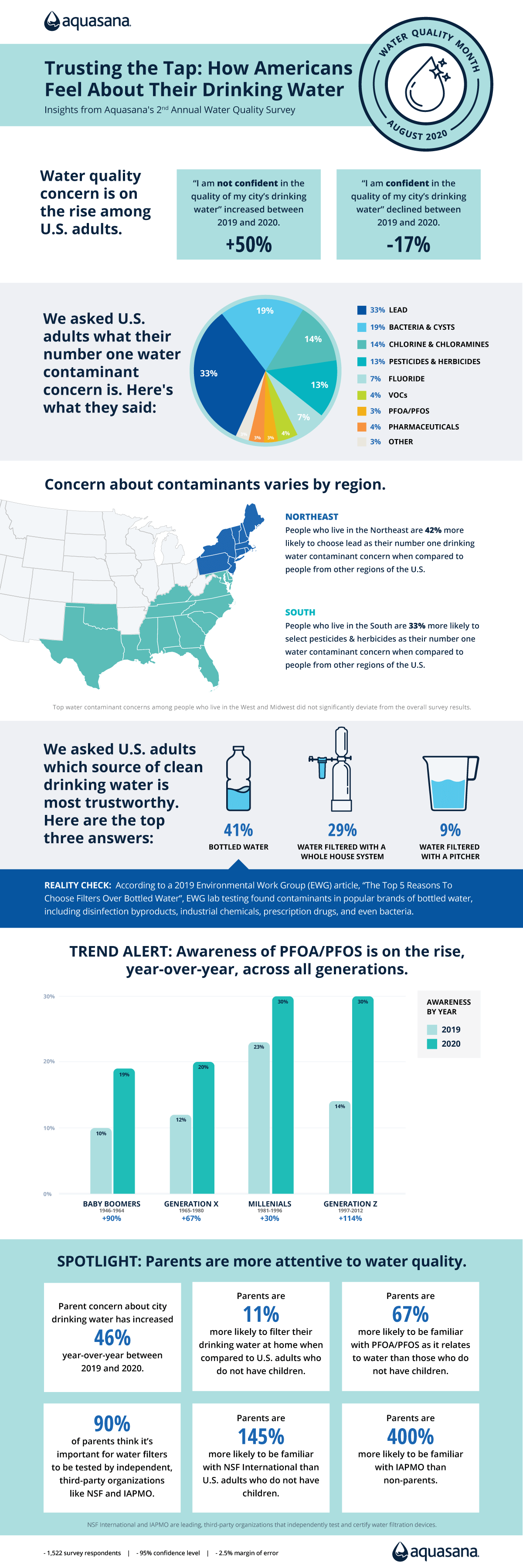Each August we observe National Water Quality Month. The goal is to spread awareness about water quality issues and make changes to help preserve water resources. To do our part during National Water Quality Month, we commissioned our second annual Water Quality Survey of more than 1,500 U.S. adults to gauge consumer knowledge and concerns about the quality of their drinking water — with the ultimate goal of uncovering insights that will help people find water treatment solutions they can trust.
This year’s water quality survey was conducted to provide insights into the following issues:
- How concerned are Americans about the quality of their city’s drinking water?
- Which common water contaminants concern Americans the most?
- What kind of action, if any, do Americans take to mitigate their water quality concerns?
- How much does the general public know about water treatment and filtration methods that effectively address their top contaminant concerns?
This National Water Quality Month, learn about our nation’s most common water quality concerns and find out how you can help address them at home.
Key survey Findings
Our 2020 Water Quality Survey asked 1,522 respondents to answer a series of questions related to their thoughts, feelings and beliefs about their drinking water. We also revisited some of the same questions we asked during our first annual Water Quality Survey to see what knowledge and trends have changed over time. To break this data down, we’ve organized our findings and other important information into the following sections:
- Key Survey Findings
- Top Drinking Water Concerns Among U.S. Adults
- Awareness Trends Around PFOA/PFOS
- Water Quality Concerns Among Parents
- Consumer Knowledge Around Water Filter Testing and Certification
- The Truth About Bottled Water
- Spread Awareness About Water Quality Issues
- Survey Methodology
Here are some of the most impactful, high-level findings from our research:
- Trust in municipal drinking water quality is on the decline year-over-year: Overall, people are less confident in the quality of municipal drinking water in 2020 than they were in 2019. The percentage of U.S. adults who stated they are “not confident in the quality of their city’s drinking water” increased 50% year-over-year (14% vs. 21%). Those that are “confident in the quality of their city’s drinking water” declined 17% year-over-year (59% vs. 49%).
- 1 in 3 U.S. adults (33%) chose lead as their top water contaminant concern: Followed by Bacteria & Cysts at 19% and Chlorine & Chloramines at 14% to round out the top three water contaminant concerns.
- Awareness around PFOA/PFOS is on the rise: We found a 44% year-over-year increase in people who said they are familiar with PFOA/PFOS as it relates to tap (or drinking) water (18% vs. 26%).
- Most people think it’s important for water filters to have third-party certifications, but the vast majority are not familiar with the leading organizations that test and certify these devices: 89% U.S. adults think it is important for water filters to be tested and certified by an independent, third-party organization, but only 17% are familiar with NSF International, and even less (11%) are familiar with IAPMO (the two leading independent testing bodies).
Continue reading below for detailed findings and insights within each of these important subjects.
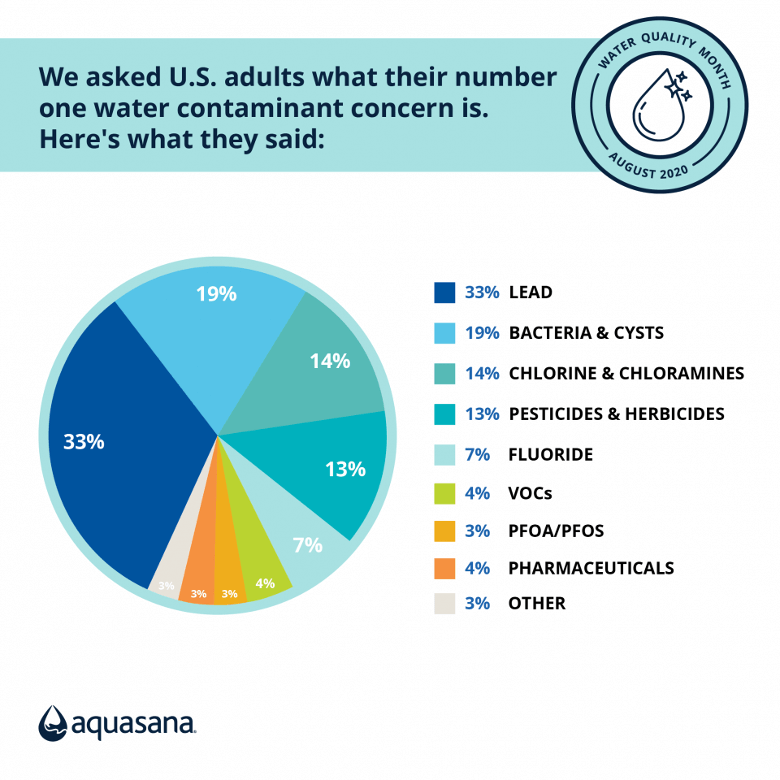
Top Drinking Water Concerns Among U.S. Adults
As a whole, Americans are less confident in the quality of municipal drinking water this year than they were in 2019. In fact, we saw a 50% increase in the number of people who said they were “not confident in the quality of their city’s drinking water” (14% in 2019 vs. 21% in 2020).
When asked to identify their top water contaminant concern, we found that lead was overwhelmingly the top response with 33% of the vote, followed by bacteria & cysts (19%), chlorine & chloramines (14%), pesticides & herbicides (13%), and fluoride (7%) rounding out the top five answers.
Differences by Age
Interestingly, we found significant differences in the top water contaminant concerns when we broke responses down into four different age groups. Lead remains the top water concern across all generations, but those in younger generations (Gen Z and Millennials) are 24% more likely to select lead as their top concern when compared to those in older generations (Gen X and Baby Boomers). Additionally, Millennials are twice as likely to identify PFOA/PFOS as their top water contaminant concern when compared to non-Millennials — which is likely because they have a better understanding of the chemicals than older generations (see section “PFOA/PFOS awareness varies by generation”).
Alternatively, those in older generations (Gen X and Baby Boomers) are 90% more likely than U.S. adults 40 or younger to list pesticides and herbicides as their No. 1 water contaminant concern. This is especially true for Baby Boomers, who are 108% more likely to select pesticides and herbicides as their top water contaminant concern when compared to other age groups. Meanwhile, fluoride was at the bottom of the list of water contaminant concerns among Baby Boomers. Only 3% of Baby Boomers selected fluoride as their top concern, compared to 8% for other age groups.
Differences by Region
In addition to differences among age groups, we also uncovered noteworthy trends that vary by region. Most notable, we identified significant differences in the concern over lead and pesticides/herbicides among people living in the Northeast and the South.
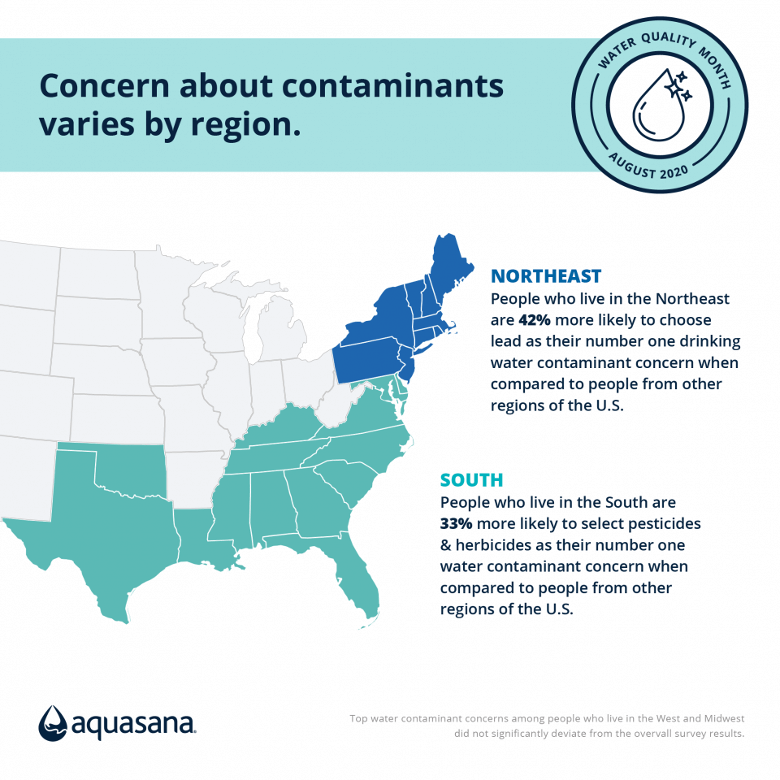
We found people who live in the Northeast are 42% more likely to choose lead as their top drinking water contaminant concern than those who live in other parts of the country. People in the Northeast are also 114% less likely to select pesticides and herbicides as their top concern when compared to non-Northeasterners (7% vs. 15%).
On the other hand, people who live in the South are 33% more likely to select pesticides and herbicides as their top water contaminant concern when compared to people from other regions of the U.S. (16% vs. 12%). People in the South are also 24% less likely to select lead as their top water contaminant concern when compared to non-Southerners (28% vs. 37%).
Communities in the Northeast are likely more concerned with lead because they have been disproportionately impacted by lead contamination due to the aging city infrastructure compared to other regions. In fact, some states in this region have up to 700,000 lead service lines still in use. On the same note, people in Southern regions may be more concerned with pesticides and herbicides due to the increased use of these chemicals in agriculture. Most notable, are the common use of herbicides such as trifluralin, monosodium methanearsonate (MSMA), and others across the cotton belt.
Awareness Trends Around PFOA/PFOS
Although PFOA and PFOS are not top water concerns among the majority of Americans, awareness around the chemicals are on the rise. In fact, our survey revealed that although the majority of Americans (74%) are still unfamiliar with PFOA/PFOS as it relates to drinking water, there was a 44% year-over-year increase in people who said they are familiar with the chemical (18% in 2019 vs. 26% in 2020).
So what exactly are PFOA/PFOS chemicals?
Perfluorooctanesulfonic acid (PFOS) and Perfluorooctanoic acid (PFOA) refer to man-made chemicals that were widely used in household products including non-stick cookware, cleaning supplies, leather, and textiles until the early 2000s. People didn’t realize the toxicity of these chemicals at the time, but in 2016, Harvard researchers found PFOA/PFOS in 194 U.S. water supplies. Additionally, they discovered how exposure to just trace amounts of the chemicals can impact the immune system, with prolonged exposure producing even more severe consequences, including potential birth defects, cancer, and heart disease.
These “forever chemicals” do not break down, meaning they will stick around in water supplies — and your body — for years to come. So while the use of PFOA/PFOS has been phased out of production processes, exposure is still prevalent today. There is no safe level of exposure to PFOA/PFOS. In 2016, the U.S. Environmental Protection Agency (EPA) released a non-enforceable lifetime health advisory (HA) of 70 ng/L for PFOA and PFOS, individually or combined. The same year, the Harvard research study also identified 33 states with levels above this EPA advisory in public water supplies.
So how do you remove PFOA/PFOS from drinking water?
One of the best ways to reduce the presence of PFOA/PFOS in your drinking water is by investing in a filter for your home. It’s important to note that not all water filters remove these contaminants. When purchasing a filter, always check for the NSF-P473 certification. This confirms the reduction of both PFOA and PFOS chemicals, and certifies that the filter is compliant with specific standards for safety, quality, sustainability, and performance. All Aquasana under sink and countertop systems have this certification, as well as our OptimH2O® Whole House Water Filter, which reduces 98% of PFOA/PFOS in addition to other contaminants like lead. In fact, Aquasana was the first water filtration company to have a system certified for NSF-P473 when the protocol was introduced in late 2016.
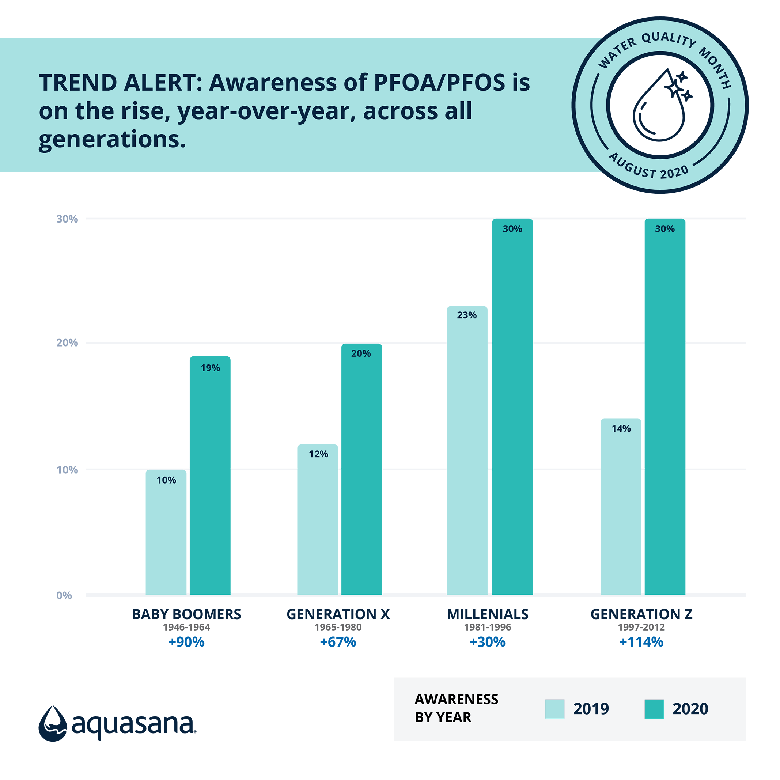
PFOA/PFOS Awareness Varies by Generation
Through our survey analysis, we found there may be a correlation between age and familiarity with PFOA/PFOS, as the younger generations (Gen Z and Millennials) are 50% more likely to be familiar with the chemicals when compared to individuals in older generations (Gen X and Baby Boomers).
Baby Boomers were the least familiar age group with regards to understanding PFOA/PFOS as it relates to water, with only 19% of the group having familiarity. On the other hand, Millennials were the most familiar age group with 30% understanding what the chemical is and how it relates to drinking water. With regard to growth, we found that Gen Z made the biggest year-over-year gains in familiarity with PFOA/PFOS with a 114% increase (14% in 2019 vs. 30% in 2020).
Water Quality Concerns Among Parents
Overall, we found parents were consistently more knowledgeable and aware of water quality issues than non-parents.
Our study found parents are 11% more likely to use some form of drinking water filter at home compared to U.S. adults who do not have children. Furthermore, parents are 67% more likely to be familiar with PFOA/PFOS as it relates to water when compared to non-parents. Both of these statistics support our findings that the percentage of parents who said they are not confident in the quality of their city’s drinking water has increased by 46% year-over-year (13% in 2019 vs. 19% in 2020).
In addition to being more aware of certain water contamination issues and more likely to filter their water at home, parents are much more likely to have familiarity with third-party testing and certification organizations such as NSF International and International Association of Plumbing and Mechanical Officials (IAPMO). Specifically, parents are 145% more likely to be familiar with NSF International and 400% more likely to be familiar with IAPMO than non-parents.
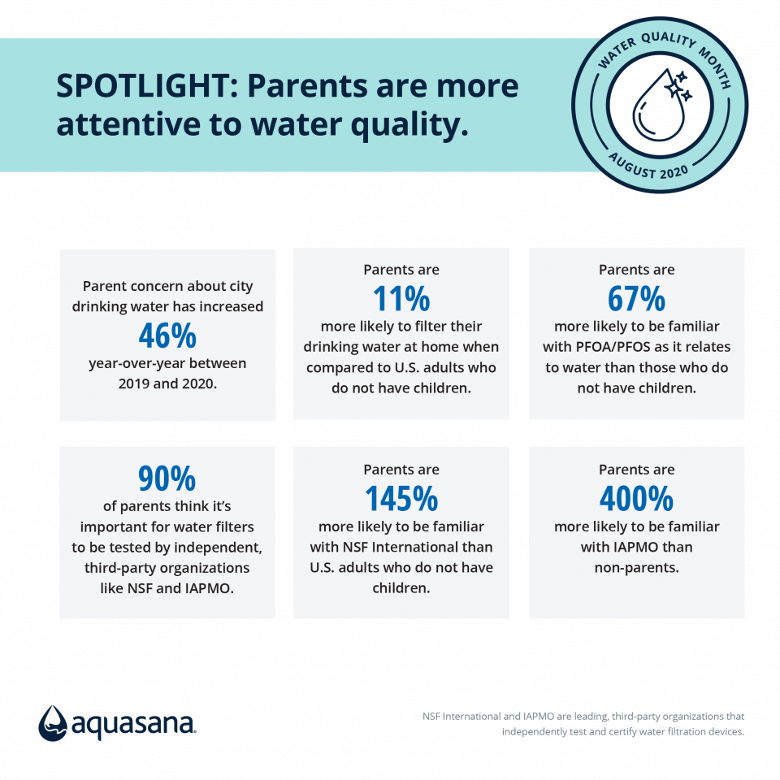
It seems parents are especially cautious about the water their children drink, which is important given that children are more vulnerable to contaminants in water than adults because of their ability to drink more water per pound of body weight. In addition, some drinking water contaminants are more harmful when exposure occurs during critical windows in a child’s development, and these exposures can have serious effects on health that continue for a lifetime. Thus, it’s essential to stay informed and take the necessary precautions to reduce children’s exposure to tap water contaminants.
Consumer Knowledge Around Water Filter Testing and Certification
We found nearly 3 out of 4 U.S. adults (73%) filter their drinking water at home, and the vast majority of U.S. adults (89%) think it is important for water filters to be tested and certified by an independent, third-party organization. However, only 17% are familiar with NSF International, and even less (11%) are familiar with IAPMO — the leading third-party organizations that independently test and certify water filtration devices.
This begs the question: does the majority of U.S. adults know which contaminants their filters are removing and if they are effective?
Who is NSF International?
NSF International is the leader in independent, third-party water certification and the not-for-profit  organization has developed a rigorous set of standards that are also used by other scientific experts to test the effectiveness of water filters in removing contaminants. To achieve the NSF certified badge on a water filter, it must be tested in NSF labs and meet several organizational standards. These NSF International standards are also recognized by the American National Standards Institute (ANSI), so you may see them listed as NSF or ANSI standards.
organization has developed a rigorous set of standards that are also used by other scientific experts to test the effectiveness of water filters in removing contaminants. To achieve the NSF certified badge on a water filter, it must be tested in NSF labs and meet several organizational standards. These NSF International standards are also recognized by the American National Standards Institute (ANSI), so you may see them listed as NSF or ANSI standards.
Who is IAPMO?
The International Association of Plumbing and Mechanical Officials (IAPMO) is another independent organization that tests and certifies products including water filters to both their own and externally-mandated standards (such as NSF). The organization has been “protecting the public’s health and safety for ninety-three years by working in concert with government and industry…” 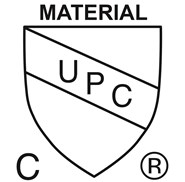
Much like NSF International, IAPMO is accredited by the American National Standards Institute and their badge indicates that products have been tested and certified to the applicable standard.
To learn more about these organizations and the standards they use, check out our in-depth article on these third party experts.
Key Takeaways About Water Filter Testing and Certifications
Overall, our survey revealed that while third-party testing is extremely important to people, the vast majority of American adults are not familiar with two of the most trusted organizations that conduct this testing and set national health and safety standards for water filters: NSF International and IAPMO.
There also appears to be a gap between people’s desire to own water filters that are tested/certified and education around which certifications to look for. Don’t be fooled into buying a water filter just because it seems easy to use and improves taste. Many contaminants are colorless, odorless, and tasteless — such as lead and PFOA/PFAS. Third party testing is the safest, most reliable way to ensure filtration products reduce harmful contaminants. Always check for the appropriate testing and certifications that address specific contaminant concerns in your water supply to ensure effective reduction.
The Truth About Bottled Water
When asked to identify the most trustworthy source of clean drinking water, 41% of American adults cited bottled water — concerning, but a common misconception. In fact, of the 27% of U.S. adults who said they do not filter drinking water at home, one-third of them stated it’s because they buy bottled water instead.
Looking at age trends, we found Gen X adults are 33% more likely than other age groups to say buying bottled water is the reason why they don’t filter their drinking water at home. From a regional perspective, people in the South are 56% more likely than those in other regions to say they don’t filter their drinking water because they buy bottled water instead. We also found parents are 30% more likely to say they buy bottled water instead of filtering their drinking water at home.
These statistics show how important it is to continue to educate people about the lack of regulation in the bottled water industry. The FDA does not require bottled water companies to disclose where the water came from, how it has been treated, or which contaminants it still contains.
Bottled Water vs. Tap Water
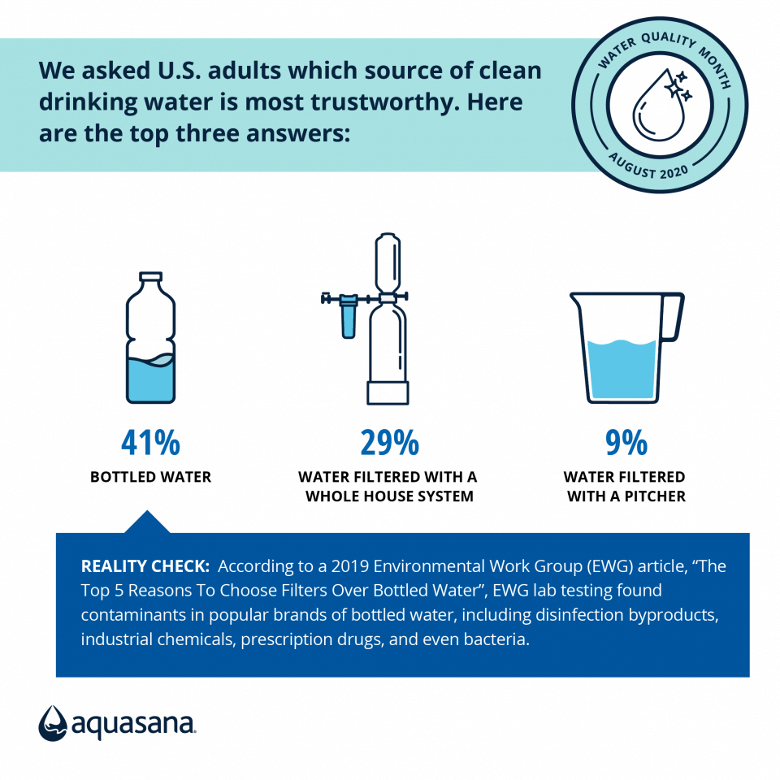
So how does bottled water compare against regular tap water?
According to a report by Food and Water Watch, the water that comes from your faucet is tested and treated far more often than some bottled water. That same report notes that more than half of all bottled water actually comes from the tap — despite the fact that it costs significantly more. For reference, a gallon’s worth of single-serve bottled water costs 2,000x the price of tap water, 3x the price of a gallon of milk, and 4x the price of regular-grade gasoline.
Even more concerning, according to a 2019 Environmental Work Group (EWG) article, “The Top 5 Reasons To Choose Filters Over Bottled Water”, EWG lab testing found contaminants in popular brands of bottled water, including disinfection byproducts, industrial chemicals, prescription drugs, and even bacteria.
Not to mention, getting water by turning on your tap is far more convenient than going out to buy bottles every week. It’s also much better for the environment, as 80% of disposable plastic bottles end up in landfills and it takes up to 1,000 years for each bottle to decompose.
So not only is tap water generally safer than bottled water because of more stringent regulations, but the safety and taste of tap water can be further improved with the installation of an under sink or countertop water filtration system. If portability is why you primarily go for plastic bottles, consider getting a reusable bottle with a built-in filter for clean, great tasting water on the go.
Spread Awareness About Water Quality Issues
Overall, our survey shows Americans have strong opinions about their water quality and majority of people filter their water at home, but there are also some knowledge gaps when it comes to understanding how effective a water filter may be and common misconceptions about bottled water.
We hope you’ll use these findings to take a closer look at your preferred source of drinking water and improve the water quality in your home. You can also help others in your community do the same by educating them to avoid bottled water, and when they go shopping for a filter, make sure they know which certifications to look for.
At Aquasana, we understand there’s a lot of unnecessary confusion about water contaminants and which filters are actually worth buying — so we aim to make things easier for people who want to enjoy healthy, great-tasting water from their faucet. All Aquasana water filtration systems are rigorously tested, and the majority are certified by either NSF or IAPMO to reduce contaminants including lead, bacteria & cysts, PFOA/PFOS, chlorine, pesticides, pharmaceuticals, and more.
This National Water Quality Month, we invite you to join us in sharing these insights to help others enjoy safer, better-tasting water in their homes.
Survey Methodology
The findings presented in this post are the result of a March 2020 survey of 1,522 Americans aged 18+ conducted by Aquasana. This is a representative sample of U.S. adults, with a confidence level of 95% and 2.5% margin of error.
Age cohorts are as follows:
- Baby Boomers: 1946-1964
- Gen X: 1965-1980
- Millennials: 1981-1996
- Gen Z: 1997-2012
Using data from the U.S. Census, regions are categorized by the following state groupings:
- Northeast – Maine, Massachusetts, New Hampshire, New Jersey, New York, Pennsylvania, Rhode Island, Vermont, Connecticut
- Midwest – Illinois, Indiana, Iowa, Kansas, Michigan, Minnesota, Missouri, Nebraska, North Dakota, Ohio, South Dakota, Wisconsin
- South – Alabama, Georgia, Kentucky, Louisiana, Maryland, Mississippi, North Carolina, Oklahoma, South Carolina, Arkansas, Tennessee, Texas, Virginia, West Virginia, Delaware, Florida
- West – Idaho, Alaska, Montana, Nevada, Arizona, New Mexico, Oregon, Utah, Washington, Wyoming, California, Colorado
